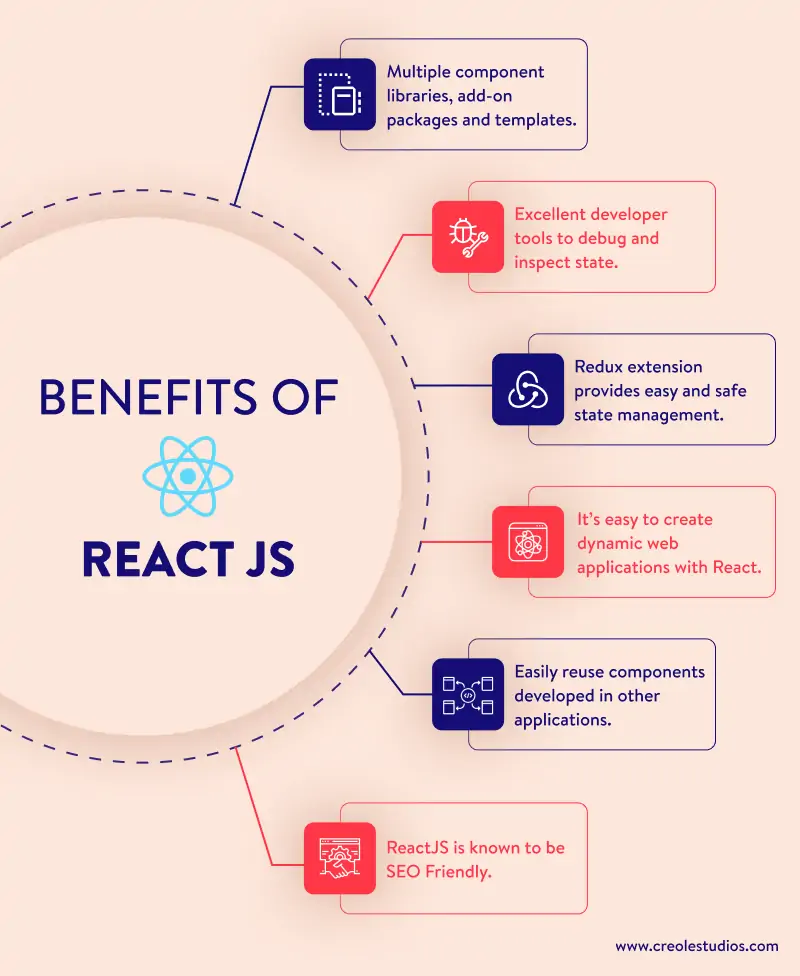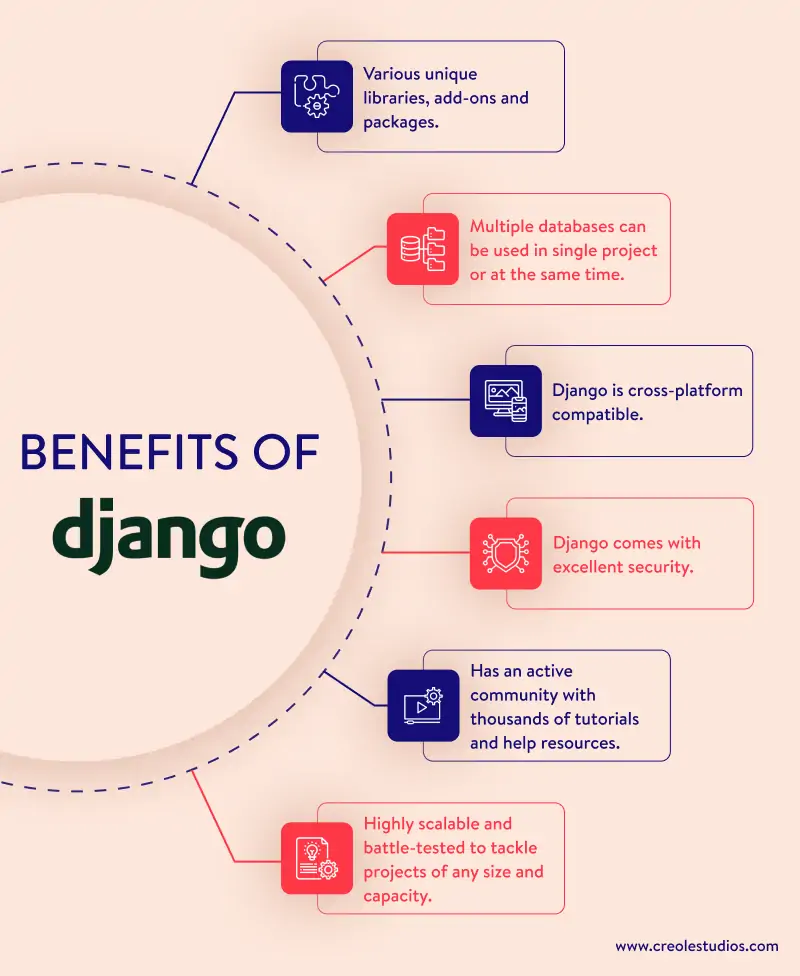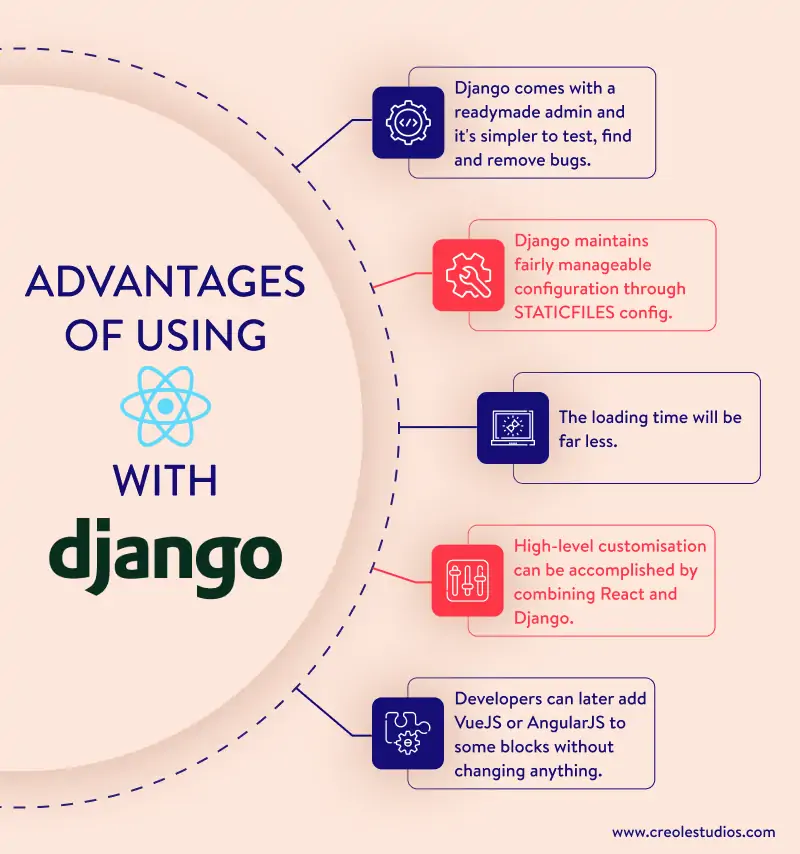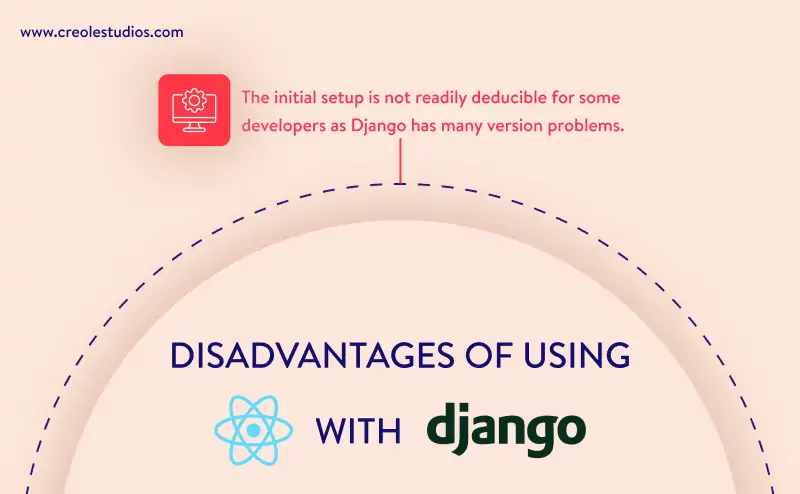Any individual well-versed with software programming has heard of Django and ReactJS technologies. While they are contrasting technologies, they can be used together to great effect.
In many developer corridors, the never-ending argument continues of whether ReactJS is a framework or library. However, one thing that we are confident about is the fact that Django is considered a full-fledged framework.
So, in today’s Creole Studios Blog, we will explore the individual benefits of both technologies, and the benefits of employing them together. So, without further ado, let’s delve in, shall we?
What is a Framework?
Before we get ahead of ourselves, it’s better if we first revise web frameworks. Typically, a website constitutes two parts: a frontend and a backend. That being said, building a website involves the configuration of tasks like: database and session management, security measures, authentications, etc.
In practice, a web framework essentially handles all those tasks as components so that developers don’t have to write them again from scratch. Put simply, frameworks make a developer’s life easy by not having to reinvent the wheel.
Though, it’s worth noting that one doesn’t technically need a framework to construct a fully functional website. A developer can choose to write all the logic they need themselves for aspects like data persistence, authentication & session handling layers, template rendering logic, security functions, or even integrated unit testing.
Regardless, if a developer uses a framework, they will be able to benefit from great features and components that are typically peer-reviewed and well tested by hundreds of other developers. As such, a framework can enable a developer to build what they want rapidly, without them spending significant time worrying too much about the infrastructure of their application.
What Is ReactJS?
Simply put, ReactJS (React.js or React herein) is a popular open-source JavaScript library utilised to create impressive modern web apps, with minimal effort and coding. Generally, ReactJS is widely known for enabling developers to build engaging User Interfaces (UI) that improve the speed of the apps.
Incepted and maintained by the social media unicorn, Facebook, ReactJS uses single components where a software developer can break down complex UI components into individual ones, thus giving great modularity and separations of concerns. As a matter of fact, ReactJS is associated with some of the top giants including Yahoo, Instagram, Netflix, PayPal, and many others.
Because of React’s ability to handle view with the input framework, it is considered by some as a framework, while others refer to it as a library. Overall, the gist of the argument lies in the technical distinction between a library and framework.
A developer employs a library when they want to control the flow of the application, while a framework is used when they want the ‘framework’ to be in charge of the flow. For better context, Angular is widely considered a framework because it controls and connects both Model and View, while ReactJS is a library since it controls only View.
Though when ReactJS was first released, it was marketed as an alternative to “Large MVC Architecture Frameworks.” So, by this premise, ReactJS is technically a framework since it forces a developer to build UIs in the React way as opposed to the Angular, Vue or Ember way (but it doesn’t fully dictate how you architecturally design your entire system, while Angular does).
However, I’d argue that caring about the contrasts between a library and framework is a bit pedantic and frivolous, so you can call it either.
How to Use ReactJS as a Frontend Tool
There are two main approaches to employing modern JavaScript frameworks. Namely, client-side rendering, where the browser downloads the required code and renders the UI, or server-side rendering, where the UI is rendered at the backend. Generally, ReactJS is well suited for Single-Page Applications (SPAs), web applications that load a single HTML page, and dynamically update that page as the user interacts with the app.
In practice, ReactJS enables developers to create reusable components that are independent of each other, making the application high-performing. This capability is facilitated by a unique feature called virtual DOM (Document Object Model) that enables developers to implement server-side rendering (SSR) without needing to update the view each time. Furthermore, the key distinction between ReactJS and older technologies is that JavaScript requires a significant amount of logic and DOM manipulation.
Benefits of ReactJS

- React comes with multiple component libraries, add-on packages and full template offerings, which save developers a lot of time, so they don’t have to build everything from scratch.
- React maintains excellent developer tools to debug and inspect state.
- React’s Redux extension provides easy and safe state management.
- It’s easy to create dynamic web applications with React, especially with clumsy HTML strings that often require complex coding. ReactJS uses the JSX to solve this issue, which is a specific syntax that lets HTML quotes and HTML tag syntax applications render specific subcomponents.
- ReactJS enables developers to reuse components developed in other applications, sharing the same functionality. This provides significant time savings, allowing developers to complete projects at a much faster pace.
- ReactJS has a less steep learning curve as developers can quickly get familiar with its features to engineer web and mobile apps.
- React allows developers to build isomorphic apps, where similar code can be used for both client and the server-side component of an app.
- ReactJS is known to be SEO Friendly, in contrast to previous JavaScript frameworks that were notoriously considered SEO unfriendly.
What is Django?
Generally, Django is a high-level Python web framework that allows developers to utilise modules for faster development. In practice, developers can use Django’s modules to build apps and websites from an existing source, thus considerably speeding up the development process, as they do not have to code everything from scratch.
Django is free and open-source, and is famously known for its advanced functionality such as admin panels, file upload support, authentication support, comment boxes, contact forms, app management, and more.
How to Use Django as a Backend Tool
Django encourages rapid development as well as a clean, pragmatic design, thus cutting out much of the hassle of web development, so developers can focus on writing their app without needing to reinvent the wheel.
A notable benefit of employing Django for backend web development is the fact that it’s a Representational State Transfer (REST) framework, which makes it a popular toolkit for building APIs. One of the main benefits of REST APIs is that they offer a great deal of flexibility. Hence, Django REST framework is essentially a highly powerful, scalable, and versatile toolkit for constructing web APIs.
Furthermore, it’s a highly scalable framework that developers can exploit for building smaller projects, before later moving on to complex applications capable of handling heavy user traffic and large data volumes. Generally speaking, many industry leaders employ Django to build all sorts of platforms, from social networks to Content Management Systems to data computing platforms. Examples of some of the busiest sites currently using Django’s ability to quickly and flexibly scale to meet heavy traffic demands are: Netflix, Spotify, Instagram, YouTube, Dropbox and Pinterest.
Benefits of Django

- Django provides various unique libraries, add-ons and packages with a lot of pre-built code. Principally, Django delivers everything required to build the backend of a web application, and competently handles most web development tasks like site maps, RSS feeds, content administration, user authentication, etc.
- Django also works with most major databases and enables the use of a more suitable database in a specific project, or even multiple databases at the same time.
- Django has a manageable learning curve, excellent documentation, and is relatively easy to set up and configure.
- Django comes with excellent security that can help protect your website or app from most of the attacks like SQL Injection, XSS, CSRF, Clickjacking, etc.
- Django REST Framework makes setting up an API on top of Django relatively easy.
- Django admin provides easy off-the-shelf views for things developers do not necessarily want to custom build in React.
- Django also boasts an active community with thousands of tutorials and help resources.
- Django is highly scalable and battle-tested to tackle projects of any size and capacity, from a simple website to a high-load web application.
- Django is cross-platform compatible, which means that a project can be based on Mac, Linux, or PC.
Benefits of ReactJS with Django
As explained, Django is a backend web framework while ReactJS is arguably a frontend framework (tending towards a library) for developing Single Page Applications (SPAs). That being said, overall, ReactJS has similar benefits to Django in terms of scalability, being battle-tested, having exhaustive documentation, an active community, and an excellent set of built-in tools that allow users to focus on the construction of software logic instead of other trivial aspects.
With regards to merging Django and React technologies, it’s essentially a canonical combination for building web software. In practice, an application that combines both technologies will have Django as backend and ReactJS as frontend. Simply put, this means that the REST API calls the backend, if any data is needed in the frontend. Since frontend frameworks require a RESTful API to interact with, developers can choose to create a RESTful backend API with Django.
Advantages of Using React with Django

- Enables good code management from both backend and frontend.
- Django maintains fairly manageable configuration as STATICFILES config will get you integrated with React pretty quickly.
- Django comes with a readymade admin, and since the frontend and backend are separated, development is less time consuming as it’s simpler to test, find and remove bugs.
- ReactJS employs states of variables that support less compact code development.
- The loading time will be far less since the frontend and backend are already separated.
- High-level customisation can be accomplished by combining React and Django.
- Developers can later choose to add VueJS or AngularJS to some blocks without changing any prebuild architecture.
Disadvantages of Using React with Django

- The initial setup is not readily deducible for some developers as Django has many version problems, which makes setups on local machines a bit time-consuming.
How to Use ReactJS and Django Together?
When using React and Django, developers typically take two approaches. The first approach is to build separate Django and React apps. In practice, Django is responsible for serving the API built using the Django REST framework, while React will consume these APIs employing the Axios HTTP client, or the browser’s fetch API. Furthermore, a developer will need to have two servers, both in development and production. In essence, one for Django (REST API) and the other for React (to serve static files).
In contrast, the second approach taken by developers involves coupling the frontend and backend apps. Fundamentally, a developer chooses to utilise Django to both serve the React frontend, then to expose the REST API. They typically integrate React and Webpack with Django, by first generating a Django project, then inside this project directory, they generate their React application using the React CLI.
Bottom Line
All things considered; Django is arguably the most complete web development framework available. It’s highly secure, fast, and scalable. With the power of Python, developers can get an app up and running in no time.
As has been noted, ReactJS is a JavaScript framework for creating single-page applications. It boasts a solid ecosystem and maintains solid documentation.
We also established that when using React and Django together, React serves as the frontend (client-side framework), that handles the UI and getting & setting data via requests to the Django backend, which is an API built using the Django REST framework (DRF).
Get your very own application built with ReactJS and Django by experienced developers from Creole Studios’ dedicated resource hiring right away! Kindly share your idea with us by contacting us, and we’ll take care of the rest.



No comments:
Post a Comment